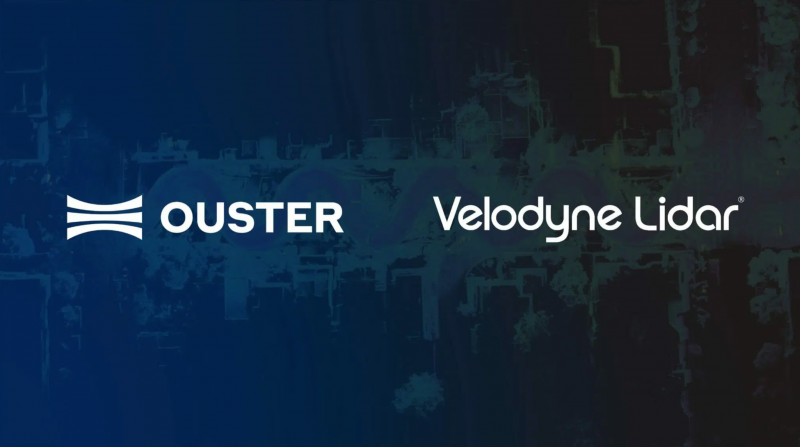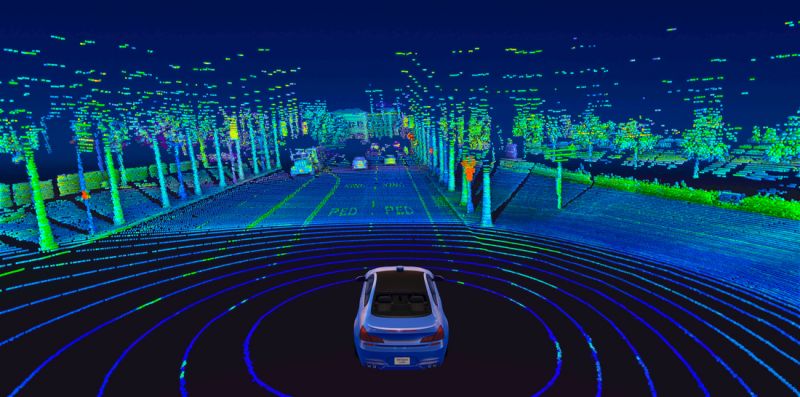US-listed LiDAR Developers Velodyne and Ouster to Merge in an All-Stock Deal
【Summary】Two of the biggest competitors in the lidar industry, Velodyne Lidar Inc. and San Francisco-based Ouster Inc., announced they will merge in an all stock deal. U.S.-listed Velodyne and Ouster will combine their customer base, partners and distribution channels to reduce lidar product costs and accelerate its adoption across fast-growing markets.

The highly competitive lidar industry, in which dozens of companies are vying for lucrative contracts with automakers, has stalled as the rollout of the laser-based perception technology in the auto industry has been much slower than anticipated.
Two of the biggest competitors in the space are Silicon Valley-based Velodyne Lidar Inc. and San Francisco-based Ouster Inc., both of which launched IPOs in recent years in order to raise capital from investors. However, each company's stock price has fallen over 75% since going public, so the two lidar developers are joining forces and announced they will merge in an all stock deal.
The proposed merger is expected to drive significant value creation and result in a strong financial position through robust product offerings, increased operational efficiencies, and a complementary customer base in fast-growing end-markets, according to a joint press release.
Shares of Ouster trade on the NYSE under the symbol "OUST", while Velodyne is listed on the NASDAQ under the symbol "VLDR".
The combined business will be equally split among the two companies' existing shareholders. Velodyne stockholders will receive 0.8204 shares of Ouster for each share they hold, which is a 7.8% premium to Velodyne's closing price on Friday.
The newly formed lidar company will have a market capitalization of roughly $400 million. The name of the new company will be announced at a later date.
The two companies will combine their customer base, partners and distribution channels to reduce lidar product costs and accelerate its adoption across fast-growing markets. The new company will also be in a better financial position with a combined cash balance of approximately $355 million as of Sept 30, 2022.
The term "LiDAR", is an acronym for "light detection and ranging". Lidar sensors emit pulses of invisible laser light which reflects back off objects. The light reflected back provides a 3D representation of a vehicle's surroundings. The lidar images can be used to identify and track other vehicles, pedestrians and bicyclists. For automakers, lidar sensors are used as an extra set of eyes on the road.
Lidar is also considered an essential sensor for self-driving cars to "see" objects when combined with cameras and radar. Lidar is also a vital sensor for vehicles equipped with advanced driver assist systems (ADAS), such as hands-free highway driving and lane keep assist. Other systems, such as Automatic Emergency Braking (AEB) and Adaptive Cruise Control (ACC), also rely on a combination of vehicle sensors, including lidar.
As more new vehicles come standard with AEB, ACC, or hands-free highway driving capabilities, lidar demand is expected to grow over the next decade, which is one of the reasons that Velodyne and Ouster launched their respective IPOs to raise capital.
"Lidar is a valuable enabling technology for autonomy, with the ability to dramatically improve the efficiency, productivity, safety, and sustainability of a world in motion," said Velodyne CEO Dr. Ted Tewksbury. "We aim to create a vibrant and healthy lidar industry by offering both affordable, high-performance sensors to drive mass adoption across a wide variety of customer applications, and by creating scale to drive profitable and sustainable revenue growth."

Lidar can render a 3D image of a vehicle's surroundings. (Photo: Velodyne Lidar Inc.)
As separate companies, both Velodyne and Ouster were competing to supply low-cost automotive-grade lidar sensors to the world's automakers. Ouster was also targeting other industries. The company is developing high-resolution digital lidar sensors for industrial automation, smart infrastructure and robotics applications.
Ouster was founded in 2015 by Angus Pacala and Mark Frichtl. The co-founders set out to build a low cost, yet high performance lidar sensor, with an explicit focus on manufacturability and affordability.
Ouster developed a high-performance digital lidar based on custom-designed semiconductors and optical innovations, which the company launched in 2018. Ouster's lidar also supports customization options, such as range, field of view, and various resolution configurations.
Velodyne is based in San Jose, CA. The company's founder and former CEO, David Hall, invented 360-degree lidar back in 2005.
Velodyne was one of the first companies to supply lidar to developers of autonomous vehicles over a decade ago, including for Google's self-driving car project in 2009 that has since become Waymo.
Over the years, Velodyne became one of the highest volume suppliers of lidar sensors to the automotive industry, with as many as 300 customers globally.
But demand for lidar sensors decreased due to the longer than anticipated deployment of autonomous driving technology in the auto industry, leaving both Ouster and Velodyne with declining orders and revenue.
Ouster shares have lost 77% of their value since the start of the year. While Velodyne's stock price was down 80% YTD before Monday's merger announcement. Velodyne's stock is currently trading below one dollar ($0.98).
"There need to be financially strong companies in this space," Ouster Chief Executive Angus Pacala told Reuters on Monday. "Necessary consolidation is happening."
Pacala will become CEO of the merged company while Velodyne CEO Ted Tewksbury will become executive chairman. Tewksbury was appointed as Velodyne CEO in Nov 2021.
The Board will be composed of eight members, with each company appointing an equal number of members. The full Board and executive team will be announced at a later date.
In March 2021, Velodyne removed founder David Hall as Chairman following an internal investigation. Also removed from her position as Velodyne marketing chief was Hall's wife Marta Thoma Hall. The investigation surrounded their dealings with the board and company practices.
In a statement at the time, Velodyne wrote, "The investigation concluded that Mr. Hall and Ms. Hall each behaved inappropriately with regard to board and company processes, and failed to operate with respect, honesty, integrity, and candor in their dealings with company officers and directors."
Former Velodyne CTO Anand Gopalan, who joined the company in 2016, was appointed as CEO in Jan 2020. But he left the CEO role in July 2021 after reports of internal conflicts at the company. Velodyne did not provide a reason for his departure.
In July 2021, Velodyne unveiled its next-generation "Velabit" lidar sensor. The improved design was intended to address the cost, safety, and design challenges of autonomous vehicles while delivering state-of-the-art performance in a compact form factor.
The Velabit lidar sensor is an automotive-grade lidar sensor designed to support both ADAS or autonomous vehicles. It was equipped with Velodyne's proprietary micro-lidar array architecture (MLA) with a high resolution, ultra-wide field of view (FoV). The FOV is also configurable with software.
The Velebit sensor can also be combined with other Velodyne lidar sensors or used as a standalone lidar solution for low-speed applications.
The merger of Velodyne and Ouster is still subject to customary closing conditions including shareholder approval by both companies. Both companies will continue to operate their businesses independently until the close of the merger transaction, which is expected to be completed in the first half of 2023.
-


Ford is Testing a New Robotic Charging Station to Assist Drivers of EVs With Disabilities
-


Ford Raises the Prices of the F-150 Lightning Electric Pickup Due to Rising Raw Material Costs
-


The BMW 7-Series to Feature HD Live Maps From HERE Technologies for Hands-Free Highway Driving in North America at Speeds up to 80 MPH
-


AutoX to Use the 'Eyeonic Vision Sensor' from California-based SiLC Technologies for its Robotaxi Fleet in China
-


LG Develops ‘Invisible’ Speaker Sound Technology That Could Revolutionize In-Vehicle Audio
-


Researchers at South Korea’s Chung-Ang University Develop a ‘Meta-Reinforcement’ Machine Learning Algorithm for Traffic Lights to Improve Vehicle Throughput
-


Zeekr’s New 009 Electric Passenger Van is the World’s First EV to Feature CATL’s Advanced ‘Qilin’ Battery With a Range of 510 Miles
-


Redwood Materials is Building an Electric Vehicle Battery Recycling Facility in South Carolina
- Zeekr’s New 009 Electric Passenger Van is the World’s First EV to Feature CATL’s Advanced ‘Qilin’ Battery With a Range of 510 Miles
- Hyundai Unveils the IONIQ 6 ‘Electric Streamliner’, its Bold Sedan With a 380-Mile Range and 18-Minute Charging Time
- Volkswagen Group of America President and CEO is Appointed to Lead the Automaker's New Electric Off-Road Truck Division ‘Scout’
- Volvo’s Electric Vehicle Brand Polestar Reports $1 Billion in Revenue in the First Half of 2022, Adds 6 New Global Markets
- Panasonic Announces Multi-Year Agreement to Supply Electric Vehicle Batteries to Lucid Group
- Rivian to Install Electric Vehicle Chargers in Michigan State Parks as Part of a New Partnership
- Volkswagen CEO Believes It Will Overtake Tesla in EV Sales by 2025
- Toyota is Working With the U.S. Dept of Energy to Advance ‘Megawatt-Scale’ Fuel Cell Powered Stationary Energy Generators
- Chevrolet Bolt EV, Bolt EUV Get Dramatic Price Cuts
- Shares of Volvo’s EV Brand Polestar to Begin Trading on the NASDAQ After Closing on its SPAC Deal With Gores Guggenheim











 About Us
About Us Contact Us
Contact Us Careers
Careers